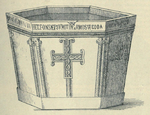Marija Bistrica | |
|---|---|
Municipality | |
 View of Marija Bistrica | |
| Coordinates: 46°0′19″N 16°07′07″E / 46.00528°N 16.11861°E | |
| Country | Croatia |
| County | Krapina-Zagorje County |
| Government | |
| • Municipal Mayor | Josip Milički |
| Area | |
| • Municipality | 68.6 km2 (26.5 sq mi) |
| • Urban | 4.0 km2 (1.5 sq mi) |
| Elevation | 192 m (630 ft) |
| Population (2021)[2] | |
| • Municipality | 5,553 |
| • Density | 81/km2 (210/sq mi) |
| • Urban | 1,045 |
| • Urban density | 260/km2 (680/sq mi) |
| Time zone | UTC+1 (CET) |
| • Summer (DST) | UTC+2 (CEST) |
| Postal code | 49 246 |
| Area code | 049 |
| Website | marija-bistrica |
| Part of a series on the |
| Catholic Church in Croatia |
|---|
 |
Marija Bistrica (Croatian pronunciation: [mǎrija bîstrit͡sa]) is a village and municipality in the Krapina-Zagorje County in central Croatia, located on the slopes of the Medvednica mountain in the Hrvatsko Zagorje region north of the capital Zagreb. The municipality has 5,976 inhabitants, with 1,071 residents in the settlement itself (2011 census).[3]
Marija Bistrica has an old Marian shrine of the Black Madonna which is a place of pilgrimage and visited by hundreds of thousands of pilgrims every year. On 3 October 1998, Pope John Paul II visited Marija Bistrica and beatified Croatian Cardinal Aloysius Stepinac in front of a crowd of 500,000 Croatians.[4]
- ^ Register of spatial units of the State Geodetic Administration of the Republic of Croatia. Wikidata Q119585703.
- ^ "Population by Age and Sex, by Settlements" (xlsx). Census of Population, Households and Dwellings in 2021. Zagreb: Croatian Bureau of Statistics. 2022.
- ^ "Population by Age and Sex, by Settlements, 2011 Census: Marija Bistrica". Census of Population, Households and Dwellings 2011. Zagreb: Croatian Bureau of Statistics. December 2012.
- ^ Bunson, Matthew and Margaret (1999). John Paul II's book of saints. Our Sunday Visitor Publishing. pp. 90–92. ISBN 9780879739348. Retrieved 28 February 2011.
